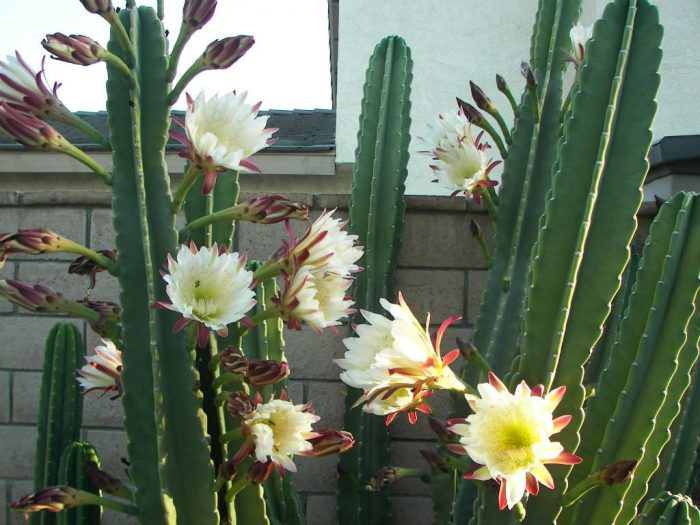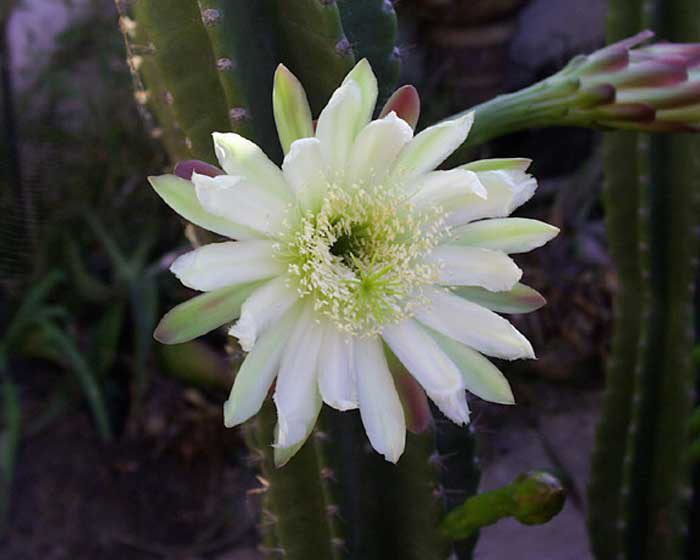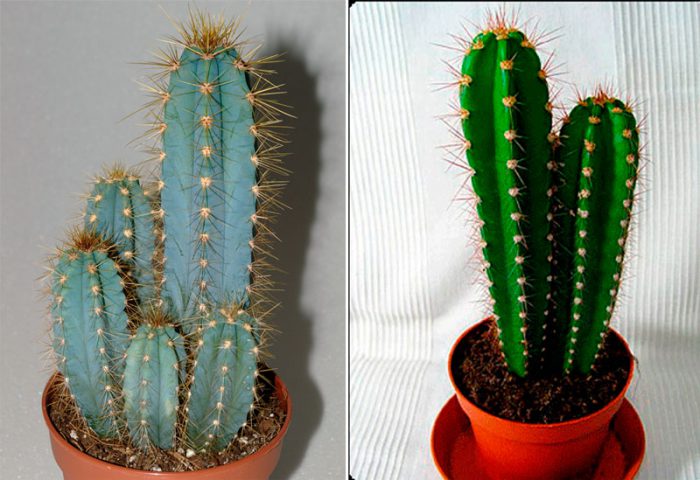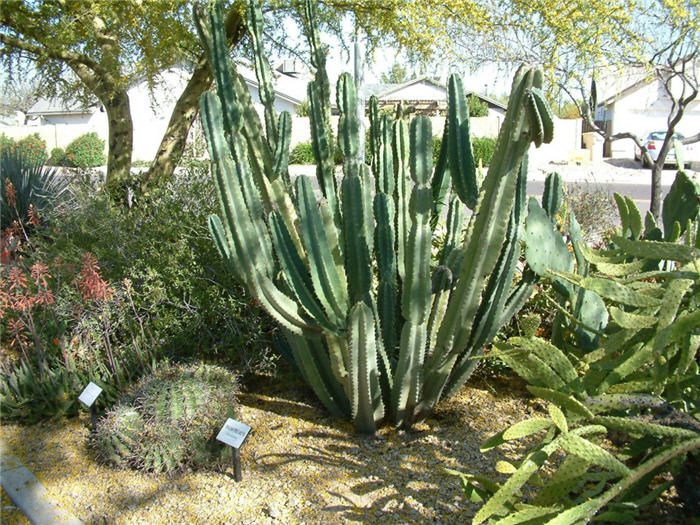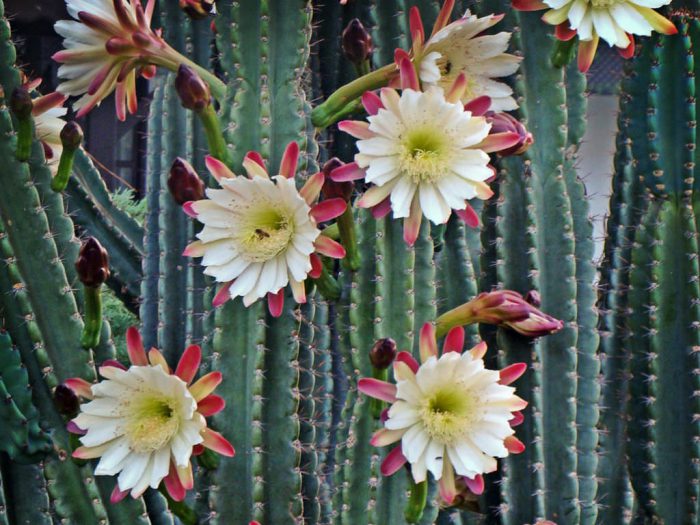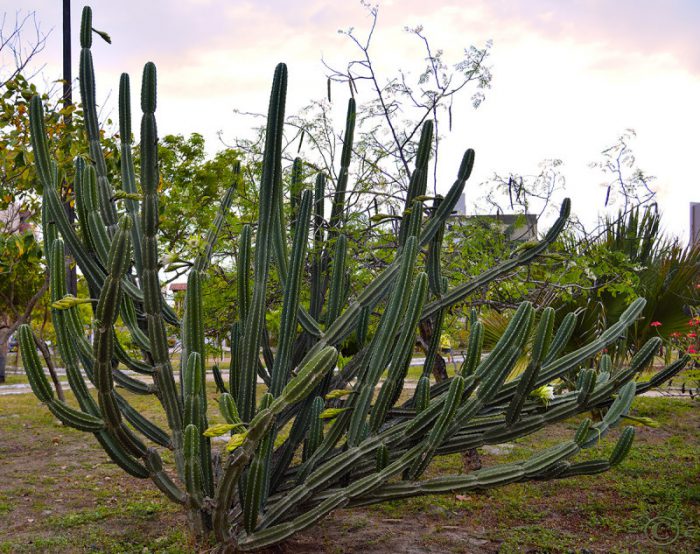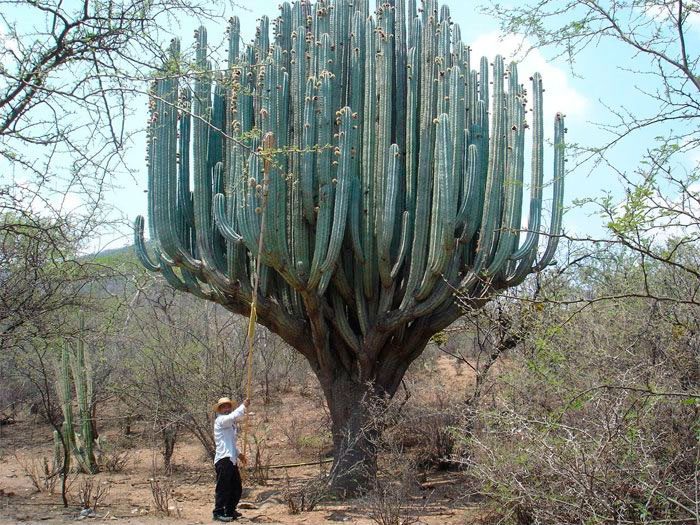Under natural conditions, a plant such as cereus is a giant (compared to a person). Most often, such cacti reach a height of 6 to 10 meters, but there are also those that grow up to 20 meters. Cereus are long-lived in the plant kingdom.
In nature, such plants are found in South and Central America, as well as in Western India.
The name of this cactus "Cereus" in Latin means "wax candle".
Such spectacular large cacti can often be seen in greenhouses, winter gardens, as well as in the spacious halls of various institutions. Often showcases are decorated with cereus.
At home, they grow quite compact varieties.
Bloom
In the wild, flowering usually occurs in May and June. Many species only bloom at night. Flowers are located on the lateral parts of the stems (laterally). Almost all species have fairly large snow-white flowers with a golden center. Their aroma is very pleasant and sometimes too strong. In some species, the flowers smell like vanilla.
The opening of flowers occurs at night. They are extremely short-lived, and fade about 24 hours after opening.
On a rather large cactus growing in the wild, several flowers are often revealed sequentially or at the same time. When grown indoors, this phenomenon is quite rare.
It is believed that at home, flowers do not form on such cactus. This is due to the fact that Cereus needs good illumination and a fairly long daylight hours for normal growth and development. If the cactus is placed in unfavorable conditions for itself, then it may not bloom at all, or this will happen extremely rarely.
The main reasons for the lack of flowering:
- poor lighting;
- all the necessary conditions are not provided during the dormant period, which is observed in winter;
- the plant is quite young;
- incorrect temperature or water regime, the room where the plant is located is very rarely ventilated.
If a plant standing in a well-lit place is properly watered, then it begins to bloom at the end of spring and early summer. It happens that the cactus begins to bloom in the autumn.
Cereus care at home
These cacti are not capricious and undemanding to care for. Thanks to this, they can be grown quite easily indoors.
Since the cereus is very hardy, it is often chosen as a rootstock for capricious and delicate plant species of the cactus family. As a result of vaccinations carried out by specialists, a large number of completely new types of cacti have been born, which have a very spectacular and extremely beautiful appearance.
Illumination
This plant is very fond of light, which should be in sufficient quantity even in summer, even in winter. It is recommended to place the cereus on a southeast or south orientation window.
Despite the fact that such plants adore the direct rays of the sun, burns may appear on their surface in spring and summer. In order to prevent this, it is necessary at the end of the winter period to accustom the cereus to direct sunlight gradually.
Temperature regime
In winter, the recommended temperature for this plant is in the range of 8-12 degrees. In the spring-summer period, the plant is not afraid of heat and sudden temperature changes. It is recommended to move the cactus to fresh air (balcony or open veranda) in the summer and keep it there until the beginning of the autumn period.
How to water
Do not water the plant with too hard or cold water. In the spring-summer period, watering should be moderate, but with the onset of autumn it should be gradually reduced. In winter, watering the cactus should be extremely sparse. Cereus reacts negatively to waterlogging, as a result of which it can weaken and get sick.
Humidity
In the spring-summer period, it is recommended to moisten the plant from a sprayer with clean lukewarm water.
Fertilizer
Cereus is a fast-growing plant that needs regular feeding for normal growth and development. It is recommended to feed from mid-spring to mid-summer. For this, liquid fertilizers are suitable, and you can water it with water, which contains the trace elements necessary for cereus.
After transplanting, you should not feed the cactus for 2 to 3 weeks, since the new soil has all the necessary nutrients.
Earth mix
A suitable substrate should be acidic or neutral, but not alkaline. Brick chips and sand must be present in the soil mixture.
Do not plant such plants in nutrient-rich soil with a high proportion of humus.
Dormant period
For wintering, the cactus should be transferred to a well-lit and warm enough place. You should not turn the cereus relative to the light of the sun during the rest period.
In winter, fertilizers cannot be applied to the soil, and the plant needs to be watered very sparsely.
Transplant features
As a rule, the cactus is transplanted as needed once every 1-2 years. A fairly tall and wide pot is chosen for transplantation.


Watch this video on YouTube
Reproduction methods
In their natural environment, such plants reproduce using seeds. But it happens that the parts that have broken off from the stem also take root (analogue of cuttings). Rocky forms of cacti in indoor conditions can only be propagated by cuttings.
Shoots are cut for cuttings. They should be left in the fresh air to dry for several days. This procedure is recommended to be carried out from the beginning of spring to mid-summer. Planting is carried out in a low pot filled with a suitable earth mixture. Moisten the soil a little. Rooting will take place after 2–4 weeks. Rooted plants are transplanted into permanent pots and tended as if they were an adult plant.
Sowing seeds is recommended from mid-April to late May. After sowing, make sure that the substrate is slightly damp (not wet) all the time. Until the seedlings appear, the container can be placed in the shade.The emerging seedlings must be rearranged in a well-lit place, protected from direct sunlight. A suitable temperature for them is 18–20 degrees.
The appearance of thorns occurs 3-4 weeks after the emergence of shoots. It is recommended to plant seedlings at this time (transplanting can be done a little later).
Diseases and pests
For preventive purposes, insecticide treatment is recommended.
For the timely detection of the disease, it is necessary to conduct systematic examinations of the folds, as well as the lower part of the stem. Spotted spots may indicate pest infestation or irrigation irregularities.
Cereus can settle spider mite, false shield, mealybug, and shield.
Whitish, slightly fluffy spots that appear indicate a mealybug infection.
The appearance of small reddish dots and cobwebs indicates a spider mite infestation. After some time, yellow dead spots form on the surface of the shoots.
False shields and scabbards can be seen with the naked eye. These are small bugs that have a round or oval shape. They feed on plant sap.
To destroy any harmful insect, the plant must be treated with an insecticide.
Rot is a fungal disease. It looks like soft brownish spots on the surface of the shoots, often depressed. If the rot is in a relatively small area, it is recommended to carefully remove it by cutting it out with something sharp. Then the resulting wound must be disinfected, for example, with alcohol. Reducing watering is recommended.
Possible problems
This plant is fast growing, which will create certain difficulties in a small room.
The scent spreading from the flowers can provoke sleep disturbance in susceptible people.
Main types
Cereus peruvian (Cereus peruvianus)
It is also called the rocky cereus. The greenish-gray stem is cylindrical and has distinct ribs on its surface. As a rule, when grown indoors, the stem reaches a height of 50 centimeters, but can grow up to 100 centimeters. Has large snow-white flowers. The opening of the smelling flowers occurs at night, while their aroma is very pleasant.
The fruit is a red or orange berry that can be eaten.
There is an extremely unusual form of this type of plant, called monstrous. The stem of this plant is strongly curved, as a result of which it forms various unusual shapes. This cactus is quite popular among gardeners due to its unusual spectacular appearance.
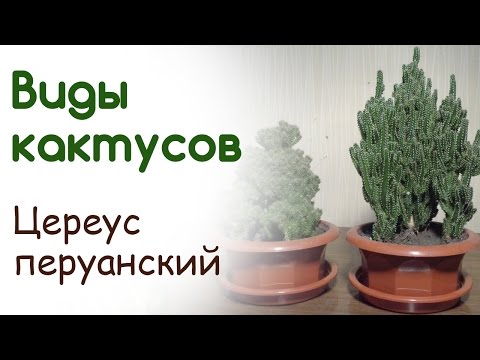

Watch this video on YouTube
Cereus repandus
According to the information found in most of the sources, this is not a separate species, but simply the second name of the Peruvian cereus.
Cereus jamacaru
The columnar stem has the shape of a cylinder, on the surface of which there are many spines of a light shade. Blossoming of flowers occurs at night. Flowers can often be up to 20 centimeters in diameter.
Cereus giant (desert giant)
In natural conditions, it can be found in states such as Arizona, California and Texas.
This species was listed in the Guinness Book of Records as the tallest cactus in the world - 25 meters.
The symbol of the state of Arizona is the flower of this cactus.
This plant differs from many other cacti in that it increases its growth rate only after reaching the age of thirty. From this time on, the shape of the trunk begins to change and many lateral processes are formed. Young specimens are rather slow-growing plants.
The fruits are juicy berries of deep red color. They can be eaten, and they have a rather pleasant taste.
Cereus validus
Young straight branching stems are blue in color. There are 4–8 ribs on the surface of the stems. Snow-white flowers.
Cereus uruguay
On the surface of the greenish-blue stem, there are 5 to 8 ribs. The thorns are sharp, they reach 2 centimeters in length.
Cereus azure
It got its name from the stem of an unusual bluish color. A powerful stem can be highly branching. The ribs are few and far between. Snow-white fragrant flowers.

